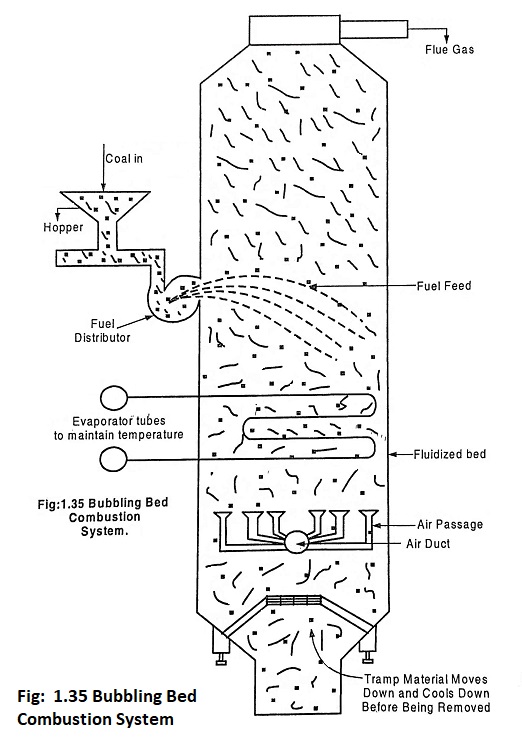Bubbling Fluidized Bed Combustion System:
In Bubbling Fluidized Bed Combustion System (or) Atmospheric bed combustion system, coal is crushed to a size of 1 – 10 mm depending upon the quality of coal and type of fuel fed into the combustion chamber. Air is used for both fluidization and combustion. Air is allowed to pass through bed after preheating, [preheating of air is done by the exhaust flue gases]. The rate at which air is blown through the bed determines the amount of fuel that can be reacted.
The Bubbling Fluidized Bed Combustion consists of sand and coal. To maintain the temperature of the bed, an evaporator tube is used which passes through the bed and extracts heat. Very little materials leaves the bubbling bed (i.e) only 2 to 4 kg of solids are recycled per ton of fuel burned.
When evenly distributed air passes upwards through a finely divided bed of solid particles such as sand on a fine mesh, the particles are not undisturbed at low velocity. As the air velocity is gradually increased to a stage the individual particles are suspended in the air stream, then the bed is known to be fluidized. With further increase in air velocity produces bubble formation, vigorous turbulance and rapid mixing. Hence bubbles are formed near the distribution plate and continuous to rise and erupt near the bed surface and ejects particles from its surfaces. Solid particles are driven upward by the bubble movement. Hence, the intensive particle circulation due to bubble movement promotes good air and solid mixing. The bed of solid particles exhibits the property of a boiling liquid and assumes the appearance of fluid called Bubbling Fluidized Bed Combustion.
If the sand particles in fluidized state is heated to the ignition temperature of coal, then the coal is injected continuously in to the bed, the coal will burn rapidly due to the heat transfer between sand and coal and bed attains an uniform temperature. Then the fluid bed combustion takes place at about 840°C to 950°C. Since the temperature is much below ash fusion temperature, melting of ash and associated problems are avoided.
The low combustion temperature is achieved because of high coefficient of heat transfer due to rapid mixing of fluidized bed and effective extraction of heat from the bed by heat transfer tube and walls of the bed.
